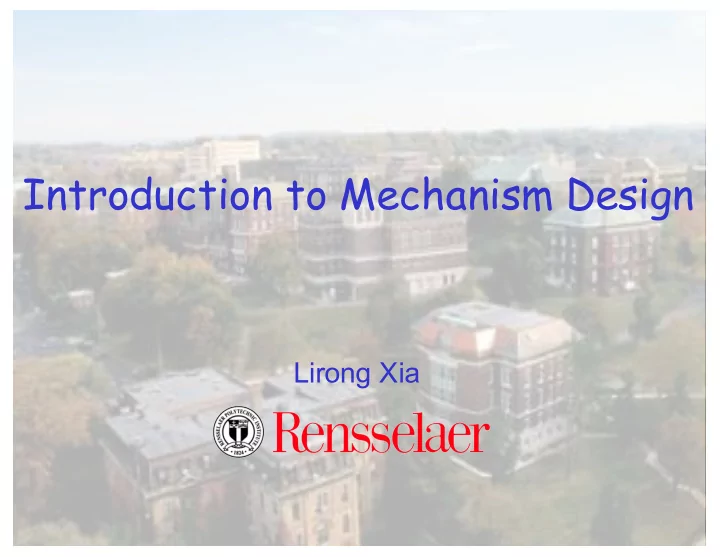

Introduction to Mechanism Design Lirong Xia
Voting game of strategic voters > > Alice Strategic vote > > Bob Strategic vote > > Carol Strategic vote
Game theory is predictive Ø How to design the “rule of the game”? • so that when agents are strategic, we can achieve a given outcome w.r.t. their true preferences? • “reverse” game theory Ø Example: design a voting rule f so that • for every true preference profile D * • OutcomeOfGame( f, D * )=Plurality( D * ) 3
Today’s schedule: mechanism design Ø Mechanism design: Nobel prize in economics 2007 Roger Myerson Eric Maskin Leonid Hurwicz 1917-2008 Ø VCG Mechanism: Vickrey won Nobel prize in economics 1996 William Vickrey 1914-1996 4
Example: second price auction Ø Auction for one indivisible item Ø n bidders Ø Outcomes: { (allocation, payment) } Ø Preferences: represented by a quasi-linear utility function • every bidder j has a private value v j for the item. Her utility is • v j - payment j , if she gets the item • 0, if she does not get the item • suffices to only report a bid (rather than a total preorder) Ø Vickrey auction (second price auction) • allocate the item to the agent with the highest bid • charge her the second highest bid 5
Example $ 10 $10 Kyle $ 70 $70 $70 Stan $ 100 $100 Eric 6
Implementation f * True Strategy Profile D * Profile D Mechanism f R 1 * s 1 s 2 R 2 * Outcome … … R n * s n Ø A game and a solution concept implement a function f * , if • for every true preference profile D * • f * ( D * ) =OutcomeOfGame( f, D * ) Ø f * is defined w.r.t. the true preferences Ø f is defined w.r.t. the reported preferences
Mechanism design with money Ø With monetary transfers Ø Set of alternatives: A • e.g. allocations of goods Ø Outcomes: { (alternative, payments) } Ø Preferences: represented by a quasi-linear utility function • every agent j has a private value v j * ( a ) for every a ∈ A . Her utility is u j * ( a , p ) = v j * ( a ) - p j • It suffices to report a value function v j 8
Can we adjust the payments to maximize social welfare? Ø Social welfare of a • SCW( a )=Σ j v j* ( a ) Ø Can any (argmax a SCW( a ), payments) be implemented w.r.t. DSNE? 9
The Vickrey-Clarke-Groves mechanism (VCG) Ø The Vickrey-Clarke-Groves mechanism (VCG) is defined by • Alterative in outcome: a * =argmax a SCW( a ) • Payments in outcome: for agent j p j = max a Σ i ≠ j v i ( a ) - Σ i ≠ j v i ( a * ) • negative externality of agent j of its presence on other agents Ø Truthful, efficient 10
Example: auction of one item $10 Kyle $70 Stan Eric $100 Ø Alternatives = (give to K, give to S, give to E) Ø a * = Ø p 1 = 100 – 100 = 0 Ø p 2 = 100 – 100 = 0 Ø p 3 = 70 – 0 = 70 11
Recommend
More recommend